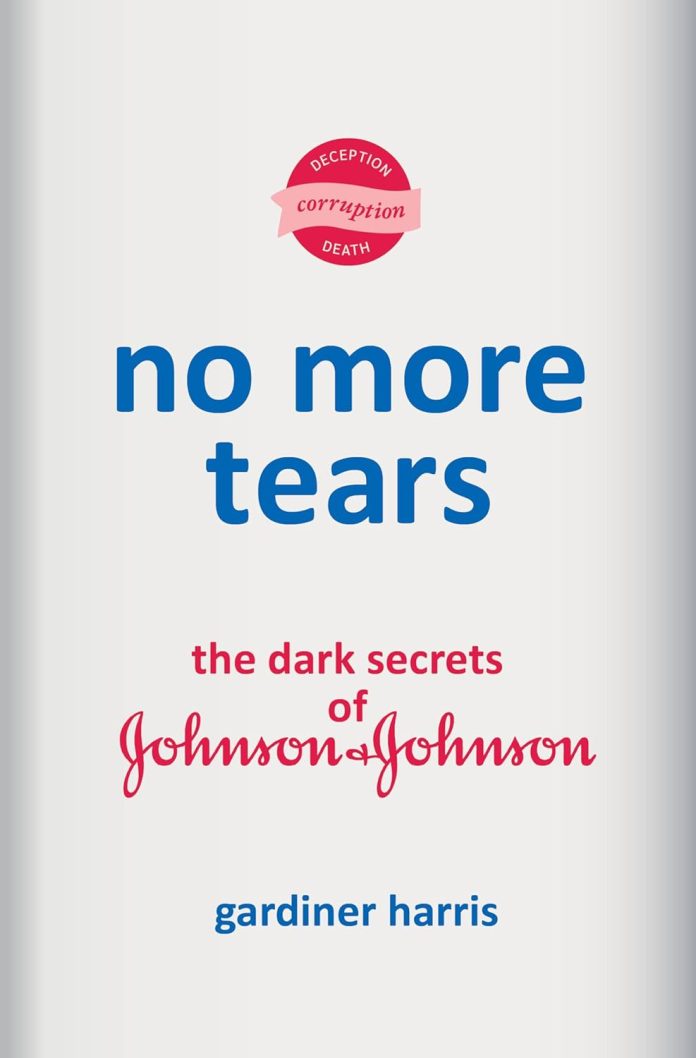In No More Tears: The Dark Secrets of Johnson & Johnson, investigative journalist Gardiner Harris delivers a searing exposé that meticulously dissects the illusion of corporate benevolence surrounding one of America’s most beloved and enduring brands—Johnson & Johnson (J&J). With surgical precision and journalistic rigor, Harris reveals how decades of deceptive marketing, regulatory manipulation, and calculated risk-taking created a mirage of trust, all while endangering public health.
This book is not just about talcum powder or Tylenol. It’s a sprawling, decades-long narrative of corporate overreach and the cultural complacency that allowed it. From baby shampoo and Band-Aids to cancer-causing powders, opioids, and medical devices, No More Tears shows that the real J&J isn’t a story of diapers and devotion, but one of deception and danger.
The Heart of the Investigation: Plot Summary
Harris’s investigation begins at an airport bar in 2004, where a casual conversation with a J&J sales rep ignites a multi-decade probe into a company that once symbolized American wholesomeness. This anecdote becomes a perfect microcosm of the book: deeply human, emotionally resonant, and quietly explosive.
Divided into four key sections—Consumer Products, Prescription Drugs, Medical Devices, and Vaccines—the book takes readers through the concealed histories of flagship products like Johnson’s Baby Powder, Tylenol, Procrit, Risperdal, and the Duragesic fentanyl patch. Through firsthand interviews, confidential documents, court transcripts, and regulatory records, Harris uncovers how J&J repeatedly manipulated science, silenced whistleblowers, and leveraged its credibility to dodge accountability.
Harris doesn’t just report. He connects. Every product story—whether it’s asbestos-laced talc or antipsychotics pushed onto children—reveals a company willing to risk lives for profit and optics.
Thematic Analysis: Trust as Currency
At the core of No More Tears lies a dissection of trust. J&J built its empire on the mother-baby bond, strategically nurturing this emotional trust to insulate itself from consumer skepticism and regulatory scrutiny. Harris underscores how the scent of baby powder and the red-script logo came to symbolize safety—even when the science said otherwise. This manipulation of trust was perhaps J&J’s greatest innovation, allowing it to commit errors that would doom other corporations.
Other key themes include:
- Corporate Mythmaking: J&J weaponized its crisis-response playbook, using the 1982 Tylenol murders to portray itself as ethically pristine, even as its distribution system may have enabled the crime.
- Regulatory Capture: From the FDA to the American media, No More Tears shows how J&J influenced or co-opted key institutions, shaping public narratives and blunting oversight.
- Erosion of Medical Ethics: The book details how doctors, researchers, and academic institutions participated in promoting off-label drug use and suppressing safety concerns, all under J&J’s generous patronage.
Critique of Writing Style and Tone
Gardiner Harris strikes a powerful balance between journalistic detachment and narrative flair. His writing is accessible yet razor-sharp, often switching seamlessly between corporate boardrooms and pediatric hospitals, legal depositions and historical retrospectives. His prose is both human and haunting, infused with the weight of real consequences.
Harris’s ability to build narrative momentum out of case studies, regulatory memos, and whistleblower interviews is particularly commendable. Rather than overwhelming readers with technical jargon, he translates complex medical and legal information into digestible, often emotional stories.
However, in parts, the book’s sheer volume of detail—especially in chapters dealing with mining operations, chemical analysis, or legal redactions—can feel overwhelming to the average reader. Some trimming or rearranging might have heightened the narrative thrust. But the depth of research more than compensates for the density.
Notable Revelations and Shocking Moments
While the entire book is built on bombshells, some revelations hit particularly hard:
- Asbestos in Baby Powder: J&J was aware of asbestos contamination as far back as the 1960s. Internal memos reveal not just knowledge, but strategic suppression.
- The Johnson Mine and the “Clean Talc” Myth: Harris debunks the notion that J&J’s talc was ever truly asbestos-free. Tests from Vermont mines consistently showed contamination.
- The Mount Sinai Scandal: J&J used pressure tactics to silence and discredit independent researchers like Dr. Arthur Langer, undermining public health in favor of brand protection.
- The Tylenol Murders and Distribution Cover-up: The widely accepted narrative that a random tamperer inserted cyanide into Tylenol capsules at retail is challenged. Harris presents compelling evidence that points to J&J’s wholesale network being breached, particularly via rack jobbers.
- Pazdur Lawsuit: Perhaps the most emotionally jarring moment is the lawsuit filed by Dr. Richard Pazdur, the FDA’s top oncologist, whose wife died of ovarian cancer after a lifetime of using Johnson’s Baby Powder.
Comparative Literature: Books in the Same Realm
Readers who appreciated books like Empire of Pain by Patrick Radden Keefe, The Cigarette Century by Allan M. Brandt, or Bottle of Lies by Katherine Eban will find No More Tears equally infuriating and indispensable. Harris shares the same investigative ethos—unflinching, meticulous, and ethically rooted. However, what distinguishes No More Tears is how personal it becomes, even as it investigates corporate giants.
Strengths
- Extensive and well-documented research: Drawing from court documents, whistleblower accounts, internal memos, and FDA correspondence, the book is deeply evidence-based.
- Narrative empathy: Despite its data-driven approach, No More Tears never loses sight of the human lives at the heart of the story.
- Institutional critique: Harris doesn’t just expose J&J, but the broader failure of regulatory and media watchdogs.
- Balanced tone: The critique is sharp but never polemical, a rare feat in a work of this kind.
Weaknesses
- Information overload: Some sections, particularly those covering the granular details of talc testing or regulatory lobbying, could have been distilled for smoother flow.
- Lack of visual or data graphics: A visual timeline or product impact chart could have helped readers track the chronology and magnitude of the events better.
- Repetitive motifs: A few internal document excerpts and whistleblower statements are paraphrased multiple times, which could feel redundant.
Verdict: A Must-Read Wake-Up Call
No More Tears is a monumental achievement in investigative nonfiction. It dismantles one of the most carefully curated brand reputations in history, exposing the deadly cost of emotional marketing and institutional complacency. This is not just a book about one company’s ethical collapse. It’s a cautionary tale about how trust can be manufactured, commodified, and ultimately weaponized.
Harris brings receipts, depth, and humanity to a story that needed telling decades ago. For consumers, regulators, doctors, and corporate leaders alike, No More Tears is required reading.
It’s a searing indictment of corporate deception—unforgiving, urgent, and essential.





